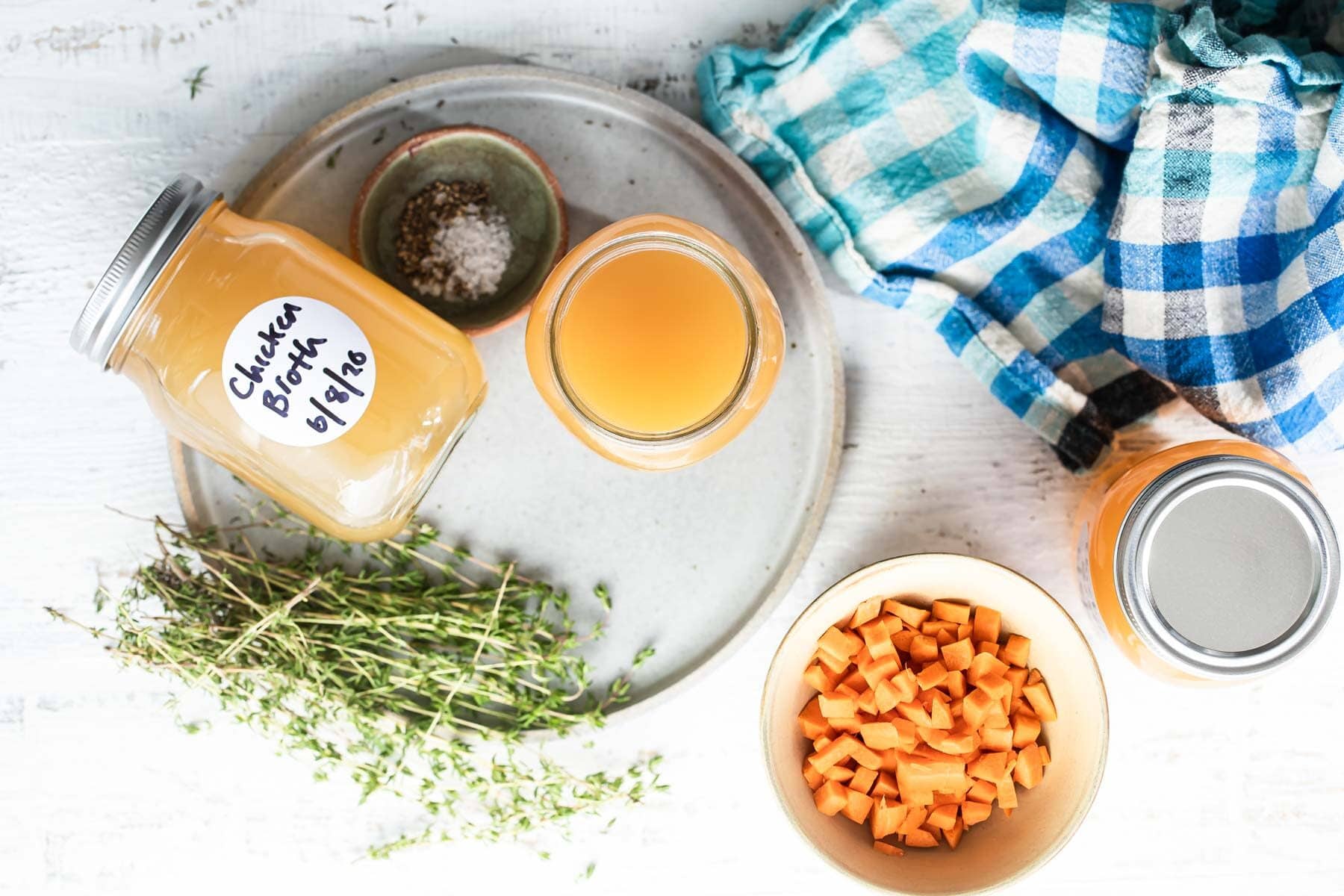What is Chicken Broth Made Of? An In-Depth Look at This Pantry Staple
Chicken broth is one of those essential ingredients that forms the foundation of countless savory dishes. But have you ever stopped to think about what exactly goes into making this flavorful liquid? In this article we’ll dive into the ingredients, process, and variations of chicken broth so you can become an expert on this versatile pantry staple.
The Basic ComponentsAt its core chicken broth consists of three main components
Chicken – This provides flavor and body. Chicken bones, especially those containing cartilage like necks and backs, are key for extracting collagen which contributes to the rich, gelatinous texture. Meat scraps also add flavor.
Vegetables – Aromatic veggies like onions, carrots and celery are classic choices. They provide sweetness, earthiness and complexity. Other options like leeks, mushrooms and garlic can also be used.
Water – The liquid that extracts flavors and nutrients from the solids. The ratio of water to bones/meat impacts the concentration and intensity.
Many recipes also include herbs for added depth, like parsley, thyme, rosemary and bay leaves. Whole peppercorns may be used too. These ingredients can be bundled into a sachet or tea infuser for easy removal.
The Simmering Process
To make broth, the chicken and vegetables are simmered in water for an extended period, typically 2-12 hours. The long, gentle simmering accomplishes several things:
- Extracts flavor compounds and collagen from the chicken bones/meat
- Softens the vegetables, releasing their aromatics
- Concentrates and melds the ingredients into a cohesive, well-rounded flavor
- Evaporates some water, intensifying the broth over time
This low and slow approach is key – a rolling boil can emulsify fats and produce a cloudy, greasy broth. Skimming the surface periodically also keeps things clear.
Broth vs Stock – What’s the Diff?
While often used interchangeably, broth and stock are not exactly the same. The main differences come down to:
- Bone to meat ratio – Stock uses more bones, broth uses more meat
- Simmering time – Stock simmers longer to extract more collagen
- Finished texture – Stock gels when chilled due to higher collagen
So broth tends to be lighter bodied with a more pronounced meaty flavor, while stock is richer and more gelatinous. But both are deeply flavorful and versatile.
Nutrition
In addition to its culinary uses, chicken broth offers some nutritional value:
- Contains electrolytes like sodium, magnesium and potassium
- Provides some protein, minerals and amino acids like glycine
- The collagen may support joint health and skin elasticity
However, store-bought broth can be high in sodium. So for the healthiest option, make your own or choose a low/no sodium product.
Tips for Customizing Your Broth
There are endless ways to adapt chicken broth to suit your tastes or dietary needs. Here are a few ideas:
- Use different chicken parts like wings, necks and feet
- Roast bones beforehand for deeper flavor
- Add mushrooms, fennel, leeks or spinach for flair
- Simmer with ginger, star anise, lemongrass or chili peppers
- Use only vegetable scraps and herbs for a vegetarian version
- Mix in miso paste, fish sauce or nutritional yeast for savory umami notes
- Opt for all organic and/or ethically raised ingredients
The options are virtually endless once you understand the basic foundations. Part of the joy of homemade broth lies in the ability to tweak and experiment over time.
How to Use Chicken Broth
Of course, no article on chicken broth would be complete without a rundown of its many uses:
- Braise or poach lean meats like chicken, fish and pork
- Deglaze pans to make flavorful pan sauces and gravies
- Cook grains like rice, quinoa, farro or barley
- Use as the base for soups, stews, chilis and braises
- Add to pans of roasted veggies to keep them moist
- Mix with vinegar and oil for a quick salad dressing
- Thin out creamy blended soups
- Add to marinades for extra moistness and flavor
And those are just a few ideas! Chicken broth is one of the most versatile ingredients imaginable, making it a true kitchen essential.
Storing Chicken Broth
Properly stored, homemade chicken broth will keep for 3-4 days refrigerated or 6 months frozen. To freeze, portion into ice cube trays or small containers leaving headspace. Thaw overnight in the fridge before using. Glass jars make attractive and practical storage vessels.
Key Takeaways
- Made from chicken, vegetables and water simmered for hours
- Gentle heat extracts nutrients, collagen and flavors
- Broth = more meat, lighter bodied; Stock = more bones, richer
- Provides some electrolytes, minerals and collagen
- Endlessly adaptable to specific tastes and diets
- An essential ingredient that forms the base of many dishes
So while it may seem like a simple pantry staple, chicken broth is actually quite complex, nuanced and versatile. Understanding how it’s made allows you to customize and use it more effectively. Keep these tips in mind and you’ll be excelling with chicken broth in no time!

Put your chicken broth to work

Recipe tips and variations
- Yield: This recipe makes about 8 cups (2 quarts) homemade chicken broth. You’ll also get 4 cups cooked chicken in the process.
- Refrigerate: Store chicken broth in the refrigerator and use within 4 days.
- Freezer: Divide the broth into freezer-safe containers (I like to use 16-ounce glass jars, but freezer bags work too) and leave 1/2-inch head space for expansion. Label and date, then freeze for up to 3 months. Thaw overnight in the refrigerator.
- Leftover roasted chicken carcass: To make chicken broth from a roasted chicken, I recommend adding the leftover roast chicken carcass to a pot with raw chicken. If you boil just a leftover roasted chicken carcass on its own, the broth will be thin and lack body and flavor.

Technically, stock is made with just bones, while broth is made with bones and meat.
You can flavor your broth with vegetables, herbs, and spices. If you don’t have much time or patience, add just a clove of garlic, a sliver of onion, and salt.
Yes, absolutely! Plain chicken broth is an absolutely delicious drink. If you want to spruce up your cup of cozy broth, try hot sauce, fresh lemon juice, and some fresh cilantro sprigs.
If your recipe calls for chicken broth, it’s looking for that extra savory flavor. You could substitute bouillon paste or cubes which will give you the same effect. But in some cases, depending on the recipe, you don’t absolutely need chicken broth and could just substitute water. But, you’ll lose flavor that way. It just depends on what you are cooking.
The Ultimate Guide To Making Amazing Chicken Stock
FAQ
Is chicken broth made out of chicken?
The stock gets its rich flavor and fattiness from the residual cartilage in the bones. Chicken broth, on the other hand, is made with chicken meat (such as a whole chicken), as well as the same mirepoix blend, herbs, and spices.
Is chicken broth just boiled chicken water?
Yes, chicken broth can be made by simply boiling chicken in water. When chicken is boiled, flavors and nutrients are extracted from the meat and bones, creating a flavorful broth.
Are broth and chicken stock the same thing?
Did you know that chicken stock and chicken broth are not the same? Chicken stock comes from the bones, is more gelatinous and has more anti-inflammatory benefits than chicken broth. Broth from chicken is generally lighter in taste and thickness than stock, and is based on the meat, not the bones.
What is chicken broth made of from the store?
I looked again at the ingredients list on a box of Swanson chicken broth. It said, in full: “Chicken Stock, Salt, Natural Flavoring, Mirepoix (Carrots, Celery, Onions), Chicken Fat, Yeast Extract.”
